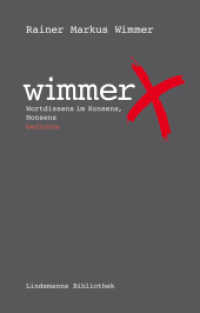- ホーム
- > 洋書
- > 英文書
- > Politics / International Relations
Full Description
There are many reasons why strategic intelligence is required to support policy decisions. These primarily stem from the nature of today's kno- edge society with two contrasting trends. On the one hand, there is a trend of increasing human intelligence in the economic, social and political s- tems. On the other hand, there is a trend towards dissolving certainties about the problems and solutions of today's society. Clearly, more inf- mation does not necessary imply more certainties on how to act. What is more, the same facts are often interpreted in markedly different ways: the same policy relevant information can - and often does - results in confli- ing framing of a problem by different stakeholders. This is mainly due to competing assumptions, rather then because of inconsistent facts. The- fore, it is not surprising that policy-makers are calling for strategic intel- gence to support their understanding of today's challenges, including the relevant aspects of science and technology, their impact and their possible future developments. Over the last 15 years, Europe has rapidly adopted the practice of dev- oping and using Impact Assessment (IA) tools to support decision-making. Formal procedures and guidance for IA are well established within the European Commission and in most EU Member States. The adoption of IA procedures alone, however, does not guarantee that every policy domain is actually using the full potential of these assessment tools in the preparation of policies and legislation.
Contents
List of Authors.- List of Authors.- Sustainability Impact Assessment: concepts and approaches.- Ex-ante Impact Assessments (IA) in the European Commission — an overview.- Impact Assessment in the European Commission in relation to Multifunctional Land Use.- An institutional analysis of land use modelling in the European Commission.- Ex ante impact assessment of land use changes in European regions — the SENSOR approach.- Transfer into decision support: The Sustainability Impact Assessment Tool (SIAT).- Scenario modelling of land use changes.- Scenarios: Driving forces and policies.- Cross sector land use modelling framework.- Tourism geography in Europe.- Landscape level simulation of land use change.- Spatial representation and data issues for European regions.- Regional socio-economic profiles for assessment of European land use related policies: the SENSOR experience.- A Spatial Regional Reference Framework for Sustainability Assessment in Europe.- Requirements for data management and maintenance to support regional land use research.- European level indicator framework.- An indicator framework for analysing sustainability impacts of land use change.- Indicators for assessing the environmental impacts of land use change across Europe.- Reflections on Social and Economic Indicators for Land Use Change.- Weighting and aggregation of indicators for sustainability impact assessment in the SENSOR context.- Regional and local evaluation.- Land use functions — a multifunctionality approach to assess the impact of land use changes on land use sustainability.- Limits and targets for a regional sustainability assessment: an interdisciplinary exploration of the threshold concept.- Sustainability Impact Assessments: limits, thresholds and the Sustainability Choice Space.-Key sustainability issues in European sensitive areas — a participatory approach.- Key sustainability issues and the spatial classification of sensitive regions in Europe.








